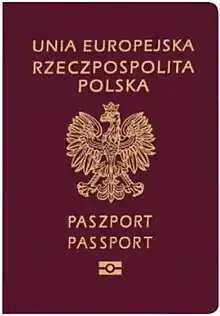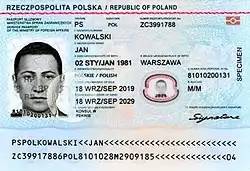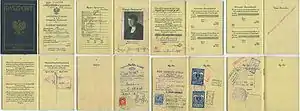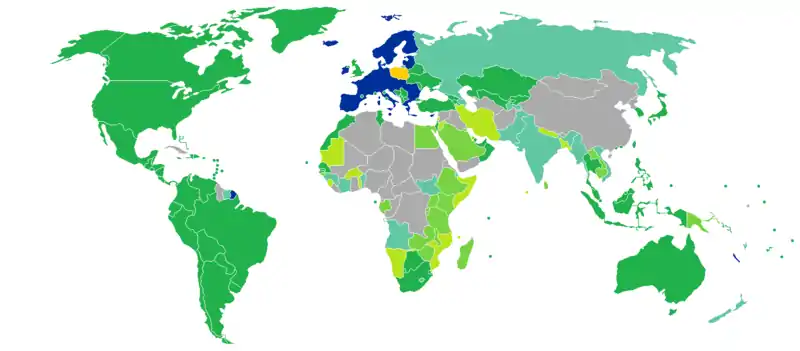Polish passport
A Polish passport is an international travel document issued to nationals of Poland, and may also serve as proof of Polish citizenship. Besides enabling the bearer to travel internationally and serving as indication of Polish citizenship, the passport facilitates the process of securing assistance from Polish consular officials abroad or other European Union member states in case a Polish consular is absent, if needed.
| Polish passport | |
|---|---|
 The front cover of a contemporary Polish biometric passport | |
 The polycarbonate data page of the current Polish biometric passport | |
| Type | Passport |
| Issued by | |
| First issued | 1 January 1992[1] (Third Polish Republic) 1 January 2006[2] (biometric version) 5 November 2018 (current version) |
| Purpose | Identification |
| Eligibility | Polish citizenship |
| Expiration | 5 years for children aged 0–13, 10 years for people aged 13+, 1 year for emergency travel documents |
| Cost | 140 zł (adult) / 30 zł (under 13) / free (over 70)[3] |
According to the 2017 Visa Restrictions Index, Polish citizens can visit 162 countries without a visa or with a visa granted on arrival. Polish citizens can live and work in any country within the EU as a result of the right of free movement and residence granted in Article 21 of the EU Treaty.[4]
Every Polish citizen is also a citizen of the European Union. The passport, along with the national identity card allows for free rights of movement and residence in any of the states of the European Union, European Economic Area, Switzerland and the United Kingdom.
Issuance and validity
The passports are issued by the Ministry of the Interior and applications are filed at voivodeship offices which have a passport office. Passports issued since mid-2006 are of a biometric variety, and valid for ten years. The blue cover passports issued up until 2001 and burgundy-cover passports (issued up until 2006) remain valid until their state expiry dates, however their lack of biometric features inherently means that they have slightly different visa restrictions for travel abroad as they are considered to have insufficient security features by some nations, such as Canada (allows visa-free access only for Polish citizens in possession of a biometric passport).
Full Polish passports are issued for a period of ten years, whilst those issued to minors are valid up to an initial maximum of five years.
Holders of passports issued before April 13, 1993 who seek to renew their passports require the additional document "Confirmation of Polish Citizenship" issued by their local provincial authority.
Temporary passports are issued for a period of one year.
Previous and current passport designs

The Polish passport from today is much different from those that appeared after World War One, following the creation of the Second Polish Republic. The passports began to appear around 1920 and were of simple paper, design and quality. These lasted until around 1929 when hard covered blue-jacket passports were designed and printed on good quality watermarked paper. These blue passports were used through World War Two and were continued to be issued to Polish refugees after the war from Polish consulates in foreign countries until at least 1947.
During the years of the People's Republic of Poland, 1952-1989, another design was adopted consisting of the Polish, French and Russian languages. In addition during this period, the crown of the Polish white eagle was absent from the emblem on the passport cover.
Physical appearance and data contained
The Polish passports issued since 2006 are burgundy, with the words "UNIA EUROPEJSKA" (EUROPEAN UNION) and "RZECZPOSPOLITA POLSKA" (REPUBLIC OF POLAND) inscribed at the top of the front cover. The Polish white eagle is emblazoned in the centre of the cover, and below this the words "PASZPORT", "PASSPORT" are to be found. The Polish passport has the standard biometric symbol emblazoned below the final set of text denoting the document as a passport, and uses the standard European Union design. Diplomatic passports are also burgundy in colour and of essentially the same design, but the French, English and Polish translations of the word 'passport' are replaced with those for 'diplomatic passport'; "PASZPORT DYPLOMATYCZNY", "DIPLOMATIC PASSPORT".
Temporary passports have the words "PASZPORT TYMCZASOWY", "TEMPORARY PASSPORT" on the front cover and contain 16 pages. They do not bear the biometric passport logo.
The statement in a Polish passport declares in Polish, English:
- THE AUTHORITIES OF THE REPUBLIC OF POLAND HEREBY KINDLY REQUEST ALL WHOM IT MAY CONCERN TO PROVIDE THE BEARER OF THIS PASSPORT WITH ALL ASSISTANCE THAT MAY BE DEEMED NECESSARY WHILE ABROAD.
The Polish statement for which is:
- WŁADZE RZECZYPOSPOLITEJ POLSKIEJ ZWRACAJĄ SIĘ Z UPRZEJMĄ PROŚBĄ DO WSZYSTKICH, KTÓRYCH MOŻE TO DOTYCZYĆ, O OKAZANIE POSIADACZOWI TEGO PASZPORTU WSZELKIEJ POMOCY, JAKA MOŻE OKAZAĆ SIĘ NIEZBĘDNA W CZASIE POBYTU ZA GRANICĄ.
Biometric data
The biometric passports contain an RFID chip containing the passport's printed data in a digital format along with the photograph in a JPEG format along with a digital key to verify that the data contained is authentic and has not been tampered with. The data in the chip can only be accessed after using the printed codes on the lower part of the passport's personal data page. The European Union requires fingerprint data to be stored on the member state's passports at latest in June 2009. Poland already complies with this European act on collecting identity data, and, since 2006, requires passport applicants to provide fingerprint scans and other information relating to facial features when applying for a new passport.
Languages
The data page/information page is printed in Polish and English, whilst translation of this information into other official languages of the European Union can be found elsewhere in the document. The passport also contains two pages reserved for official notifications which are typically only recorded in Polish.
Visa free travel

Visa requirements for Polish citizens are administrative entry restrictions by the authorities of other states placed on citizens of Poland. Polish citizens enjoy freedom of movement in the European Economic Area and can travel around the EEA as of right. As of July 2019, Polish citizens had visa-free or visa on arrival access to 172 countries and territories, ranking the Polish passport 16th in terms of travel freedom according to the Henley Passport Index.[5]
Gallery of Polish passports
- Passport gallery
 1918 Polish consular validation of a passport
1918 Polish consular validation of a passport 1932 Official Polish passport issued by the Foreign Ministry in Warsaw
1932 Official Polish passport issued by the Foreign Ministry in Warsaw 1934 Passport of the Second Polish Republic
1934 Passport of the Second Polish Republic Polish service passport used by an employee at the consulate in Germany 1936–1939
Polish service passport used by an employee at the consulate in Germany 1936–1939 First post-war Polish passport, used in the second half of 1945
First post-war Polish passport, used in the second half of 1945 PRL internal passport (valid for Eastern Bloc)
PRL internal passport (valid for Eastern Bloc) PRL passport's cover (until fall of communism - 1990)
PRL passport's cover (until fall of communism - 1990) Passport cover prior to 2001
Passport cover prior to 2001 Passport cover 2001-2006
Passport cover 2001-2006 Passport cover 2007 (non-biometric)
Passport cover 2007 (non-biometric) Polish passport prior to 6 November 2018
Polish passport prior to 6 November 2018
See also
References
- Treaty on the Function of the European Union (consolidated version)
- "Global Ranking - Passport Index 2019" (PDF). Henley & Partners. Retrieved 3 July 2019.
| Wikimedia Commons has media related to Passports of Poland. |